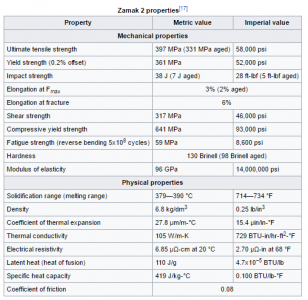Here are the basics on Zamak vs. Cast iron from Wikapedia:
Chart is for Zamak 2 which added some copper to the alloy (primarily zinc) to make it stronger. Yield strength (put a load on the part and it starts to permanently deform) - 52,000 psi. Ultimate tensile strength (when it breaks under load) - 58,000 psi. Depending on the cast iron, the yield strength (really the number we care about) - anywhere from 25,000 psi to 105,000 psi.
Another property is modulus of elasticity. It's the slope of the line when you plot stress vs. strain or basically load vs. deflection. Young's modulus for Zamak is 14,000,000 psi. Steels/iron are around 28,000,000 - 30,000,000 psi. That means a Zamak part will deflect about twice as the same part in steel or iron under the same load. But the point where they start to permanently deform could be the same depending on the type of cast iron.
I suspect Atlas used a lot of Zamak in strategic parts because of the melting point of 734 F instead of 2200 F for iron. It's a lot easier and cheaper to make a steel die and cast gears instead of cutting them individually. As Robert and others have noted, lots of Altas/Craftsman lathes and mills out there with Zamak gears that have held up really well. You'll see many posts here about broken gears (especially in the back gears) on lathes that are most likely steel, so no material is indestructible.
If you see a broken Zamak part, theoretically it's not a problem with the Zamak but a design/use problem. I have an Atlas MFB mill with a broken power feed gear box for the table. The mounting ears snapped off the box itself. My first thought was "I sure wish they'd have made that part out of steel"! However, looking at the material charts, it wouldn't have made a difference. The mounting ears were unbeknownst to me cracked when I bought the mill. One of these years I'll remake the box and reuse the guts, but will make the mounting ears more robust (thicker). I've seen ads on eBay for "repaired" gear boxes where the mounting ears were cracked, so I suspect there's a bit of a design issue with the gear box.
That Atlas lathe in Bedford looks to be a pretty good deal. It'll serve you well for many years if you work within its limits. I've read posts here where guys have taken something like 0.100" off the radius of steel on a lathe. I'm not in a rush to do anything and don't think I've ever taken a DOC deeper than 0.030" on the radius on a lathe turning steel, maybe 0.040" on aluminum; haven't broken one of my machines from use yet (Rockwell 10 x 36 lathe, Clausing 12 x 24 lathe and Grizzly 14 x 40 lathe). I might not be removing stock at the optimum rate, but I'm not a production shop getting paid by the minute. If I break something I have to fix it, so I chose to be a "sissy" and not push the machines to the breaking point. That Atlas lathe will treat you as well as you treat it!
Bruce




